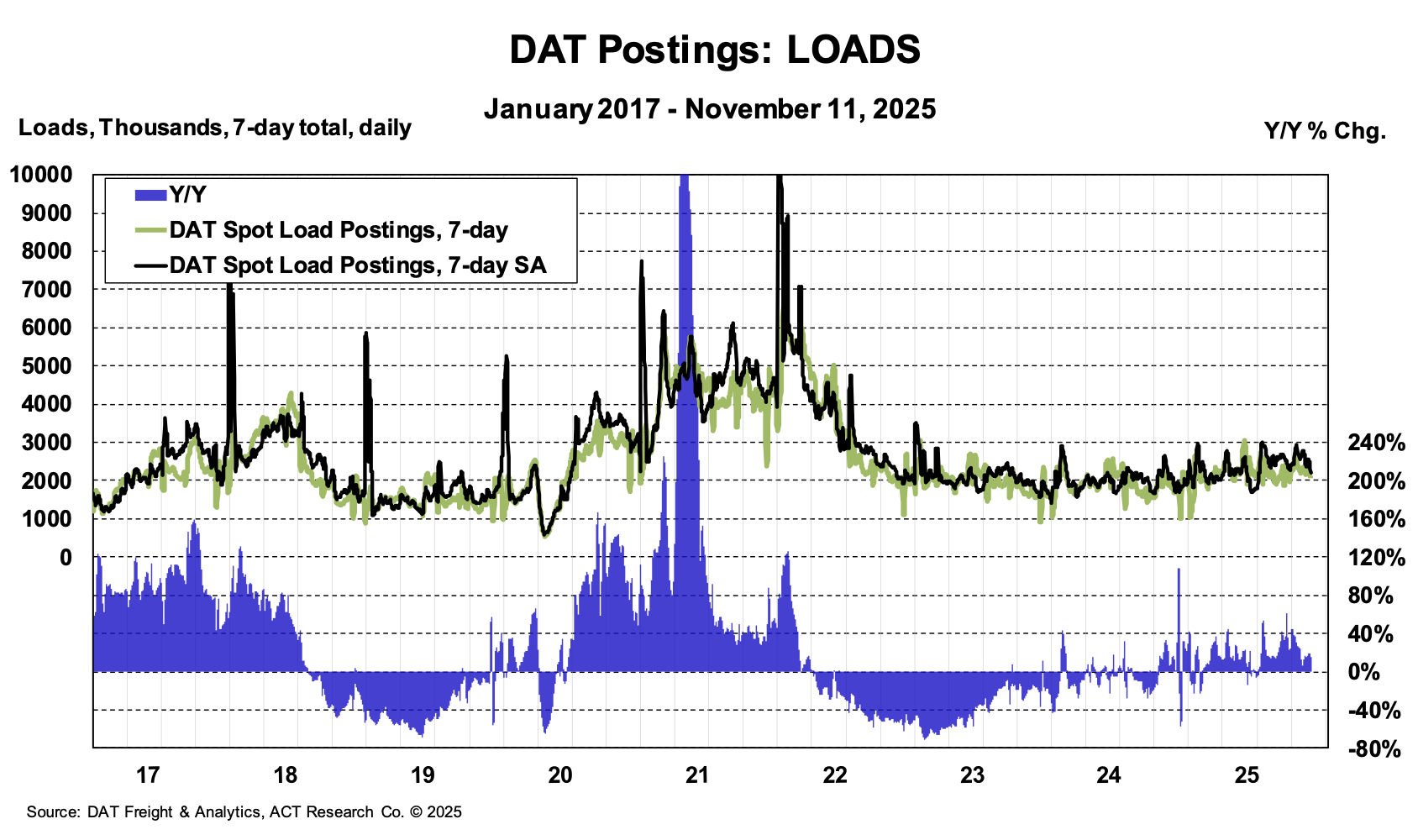
Dry Van Rates
Dry Van Rates - November 2025
Update November 21, 2025
Dry Van Truckload (TL) Sector
November 2025 Update
As of October 2025, the dry van truckload (TL) sector continues to face weak freight demand, tariff-related cost pressure, and an ongoing market imbalance. The brief pre-tariff shipping bump from mid-summer has fully unwound, and November data from ACT Research shows spot activity slipping again as capacity returns and load-posting activity normalizes. Freight fundamentals remain soft, and fleet sentiment is increasingly defensive as carriers grapple with another quarter of recession-level margins and a lack of rate momentum.
According to ACT Research’s November Freight Forecast, capacity continues to exceed freight volumes, and regulatory uncertainty—particularly around EPA 2027—remains a major barrier to new investment. Private fleets continue to capture share, contributing further to sluggish for-hire rate performance.
Spot Market Rates
Dry van spot rates softened in early November after showing modest firmness in October. As the pull-forward from pre-tariff freight faded, load postings declined and equipment postings rose, bringing the load-to-truck ratio back toward late-summer levels. Rates remain below seasonal norms, with no visible catalyst for sustained improvement absent a freight rebound or meaningful capacity contraction.
Retail and consumer-goods freight remains weak. Lean inventories, cautious consumer spending, and fading import demand continue to limit dry van volume recovery. ACT notes that the market has returned to a pattern of “brief tightening followed by renewed softness,” consistent with current payback dynamics. With goods demand slowing further into Q4, rate pressure is expected to persist into early 2026.

Contract Market Rates
Dry van contract rates were stable in October and early November, holding within a narrow band for the fourth consecutive month. With spot rates sliding again, the spot/contract spread widened slightly—reinforcing shippers’ continued negotiating leverage.
Most early-2026 bid cycles are still centering around low-single-digit adjustments, broadly aligned with ACT’s November forecast. With private fleets maintaining elevated capacity and for-hire margins remaining compressed, carriers continue to emphasize:
-
Equipment lifecycle extension
-
Asset productivity improvements
-
Maintenance, insurance, and fuel cost control
-
Operational efficiency over network expansion
Tariff-driven equipment cost inflation and elevated financing expenses remain key constraints on replacement activity, keeping fleets cautious.

Outlook
The dry van TL market remains in a defensive phase as freight demand stays muted and rate fundamentals show limited improvement. The temporary lift from pre-tariff activity has fully reversed, and carriers continue to navigate elevated costs, thin margins, and policy uncertainty.
With consumer demand softening, inventories lean, and the EPA 2027 low-NOx rule still unresolved, equipment investment remains highly conservative. Tariff-driven price pressure and tightening credit conditions continue to reinforce longer trade cycles.
Unless the Supreme Court overturns the current 232 heavy-vehicle tariffs or broader economic conditions strengthen materially, the dry van segment is expected to remain oversupplied, margin-constrained, and replacement-driven well into 2026.
To see how dry van rates change in the future, and for detailed analysis and forecasts for truckload, less-than-truckload, and intermodal, see ACT's freight & transportation forecast.
As of late September 2025, dry van rates remain below seasonal norms, with spot pricing leveling after a short-lived lift from pre-tariff shipping. Regional demand pockets and modest back-to-school retail activity offered limited support, but overall market conditions remain weak. With capacity still ample, inventories lean, and consumer goods freight subdued, sustained rate momentum continues to elude the market heading into the fourth quarter.

Tim Denoyer
VP & Sr. Analyst

Resources
Whether you’re new to our company or are already a subscriber, we encourage you to take advantage of all our resources.